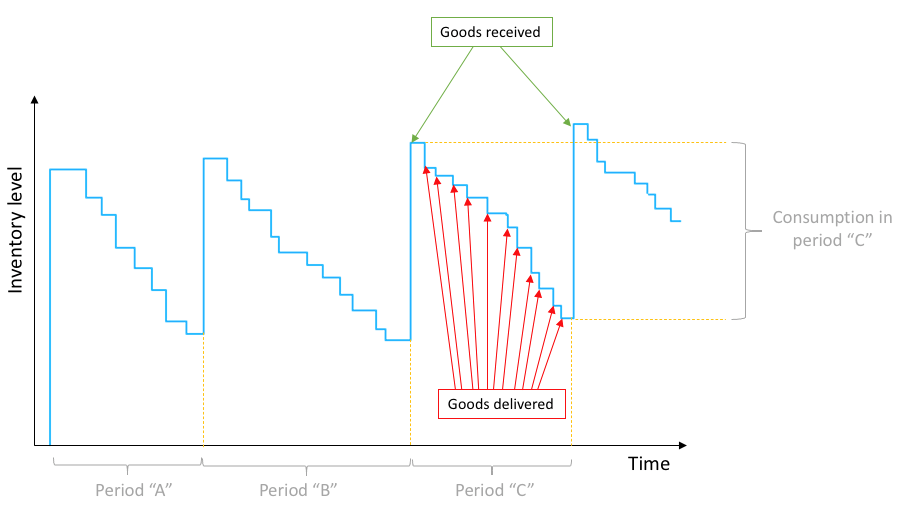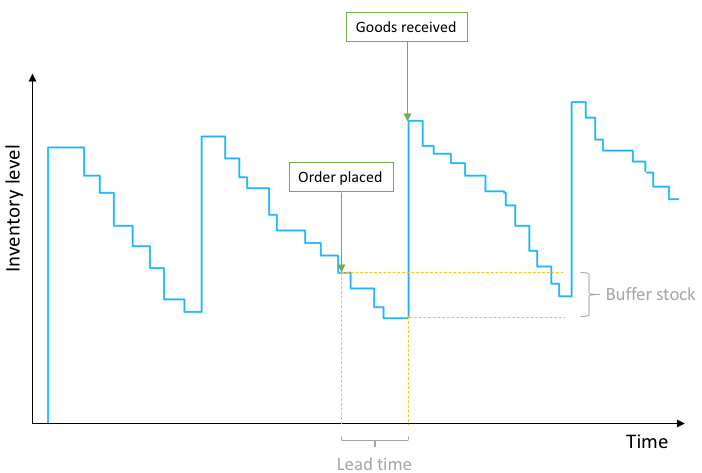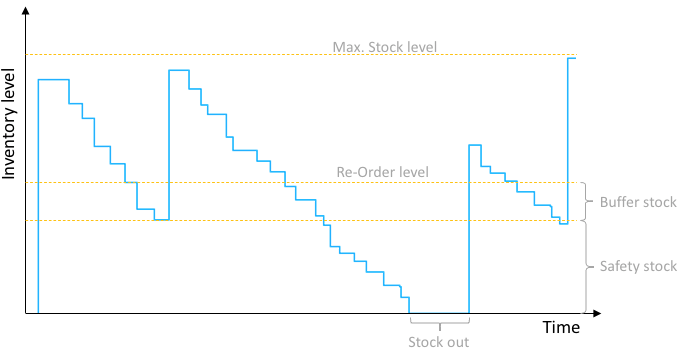Keeping inventory levels optimal at all times is achieved when demand is fulfilled on time while resources such as time, space, effort, and expenditures are efficiently managed. Deciding what is the appropriate inventory level requires a good knowledge of demand patterns (forecast) and supply capacity (scheduling) - both are necessary to decide when to order and the period to be covered.

The Order Cycle
Movements of goods within a storage facility can be summarised in “INs” (when goods are received) and “OUTs” (when goods are delivered). The balance between inbound and outbound movements in the warehouse determines the inventory level. The quantity of stock delivered during a certain period of time is defined as consumption, normally measured in items/time. The period of time between two successive regular orders for a particular item in stock is called "re-ordering cycle."

Goods are not automatically restored in the warehouse - a re-ordering process must take place. Agencies must place an order of a certain quantity and wait for its reception. The time lapse between the moment when the order is placed and the moment of its reception is known as “lead time”. The amount of stock consumed during a standard lead time is known as “buffer stock”.

The lead time for the critical items in the storage facility must be well known. The balance between consumption and lead time will allow defining the optimal buffer stock.
Despite keeping a buffer stock, "stock-outs" may occur. Stock-outs are defined as stock of one or more items being fully depleted. Stock-outs occur when anticipated orders are long-overdue, when actual lead times are longer than expected lead times, or when consumption is significantly increased. To prevent stock-outs from occurring, a safety stock should be maintained. “Safety Stock” is a quantity of extra stock that is kept to mitigate risk of stock-outs caused by uncertainties in supply and demand. Common examples uncertainties in relief operations might include access constraints, harsh climate events, or increased needs due to changing social conditions. Awareness changing situations and the associated potential supply chain bottlenecks can help planners design a safety stock appropriate to the operational context.

Once buffer stock and safety stock levels are defined, a “reorder level” should be established. Reorder level (or Re-Order Point - ROP) is the minimum stock level of any given item before another order is placed. Reorder levels must be sufficiently high to allow regular replenishment of stock before reaching a critical situation and a potential stock out. The reorder level is calculated by adding the safety stock to the buffer stock.
When defining reorder levels, agencies should consider that storage facilities have a limited capacity. Planners should define the maximum space available for each of the stored items and establish a maximum stock level for each item. This is especially critical when storing items requiring specific storage conditions, such as temperature sensitive goods or dangerous materials, for which allocating extra space may not be immediately available. To allow a certain degree of manoeuvrability, the “maximum stock” level should not be reached.
Inventory Components
Correct inventory management requires a broader vision than just inbound and outbound movements. Understanding different ways to visually manage inventory is important in supply chains with long transport periods, limited storage capacity, or high rotation of items or where different orders overlap in time.
From the moment an item is ordered until the moment the item is received and dispatched, the item passes through different states:
- On hand/Running Inventory - The current stock in the storage facility. It is the number of available units of a certain SKU for running operations.
- In transit Inventory - The stock being transported between two locations. Although not in a warehouse, supplies in transit remain property of the organisation and should be recorded/accounted. It is common for senders to deduct an item from inventory controls before the receiver accepts it. In transit tracking is particularly important when transit between facilities or to a delivery location may take long periods.
- Committed inventory - Stock that is committed to a particular order or transfer. While “on hand” inventory is the number of available units, “committed” inventory are items which are physically in the warehouse but are not technically available.
- Ordered Inventory - Stock that has been ordered to replenish the inventory but is not yet received. If an order is partially received, the remaining quantity is called back-order. If inventory back-orders are a frequent occurrence, it may be necessary to evaluate the inventory control procedures.

